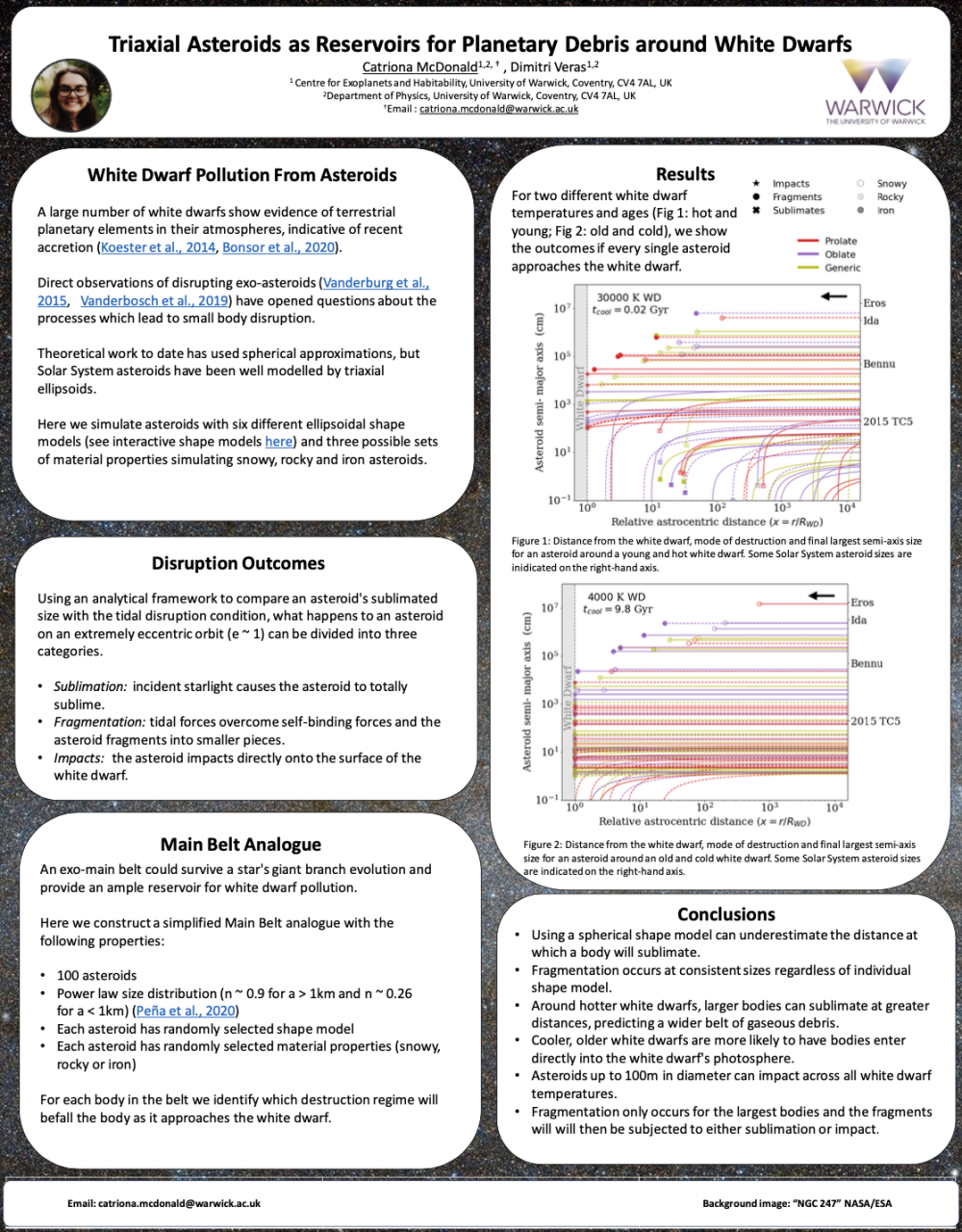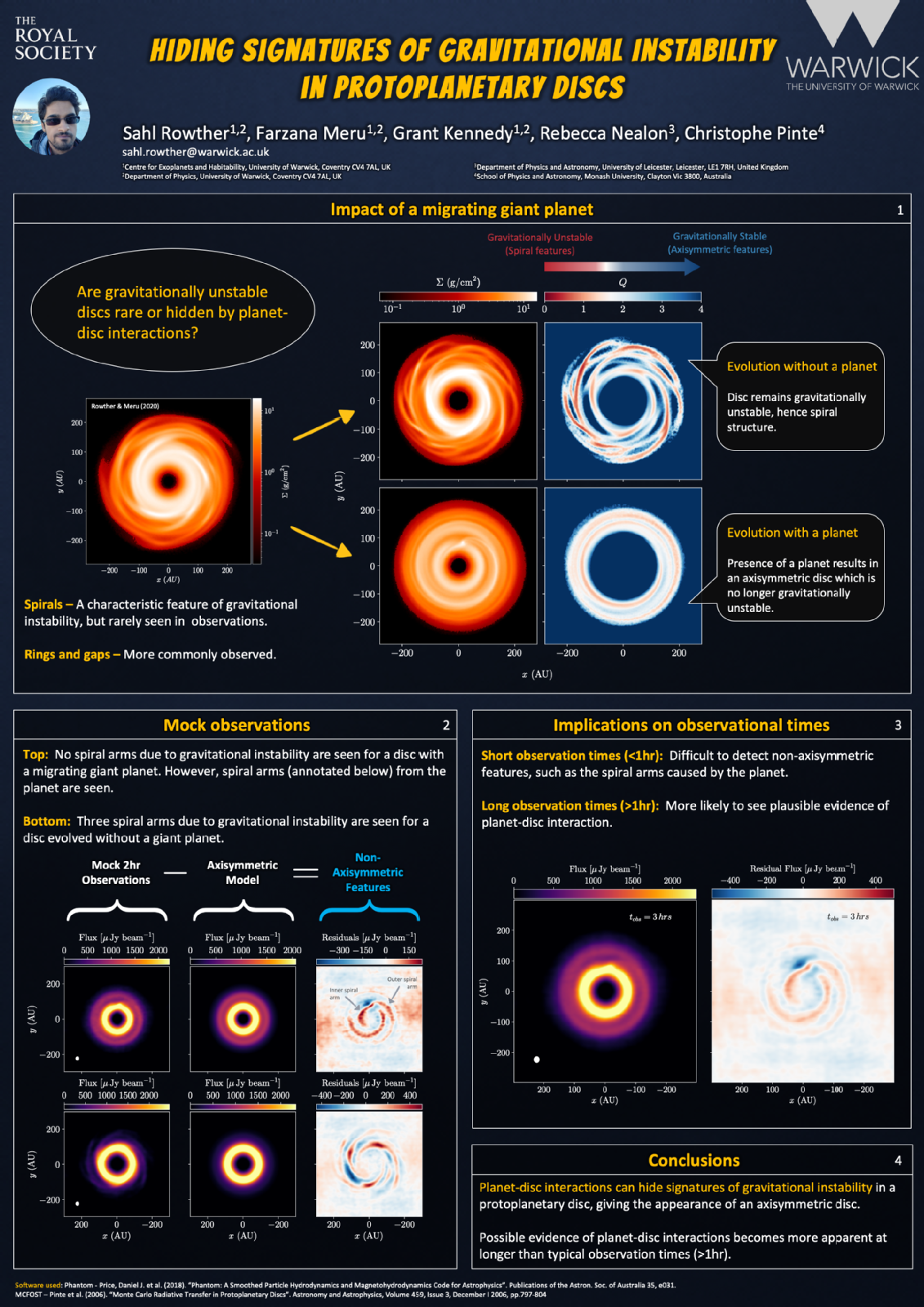Research News & Highlights
UKI Discs Meeting 2024 to be hosted at the University of Warwick
Our discs group recently started the UK & Ireland (UKI) Discs community, where we aim to bring together the disc communities across the UK & Ireland for those working on astrophysical discs on various scales, from circumplanetary to galactic discs. We are excited to announce the first UKI Discs Meeting will be hosted at the University of Warwick from the 9th - 11th of September 2024 and will focus on protoplanetary discs and debris discs (including white dwarf discs). To register and find out more, follow the link hereLink opens in a new window.
The abstract submission deadline for talks/posters is the 12th of May 2024.

RAS Specialist Meeting - Formation, Evolution and Dispersal of Protoplanetary Discs
Amena Faruqi -- Simulating the Transit of a Binary System by a Circumbinary Disc in the HD98800 System
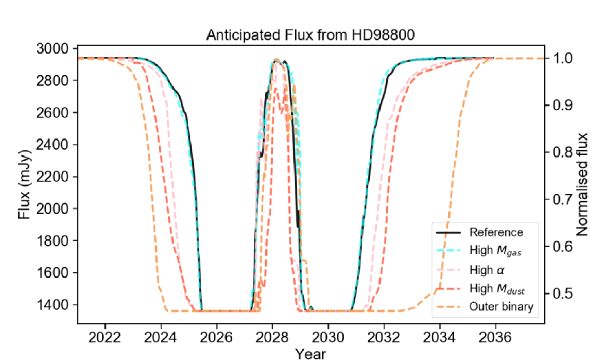
The properties of circumbinary discs play a significant role in star-disc interactions in binary systems. However, there are gaps in our current understanding of how various disc properties, such as the disc mass, viscosity, and dust-to-gas ratio, can affect the dynamics and evolution of such a system. In order to better understand the influence of these properties, it would be ideal to study a system where the stellar parameters are well-constrained, and the disc can be imaged. One such system is the HD98800 system, a quadruple star system consisting of two binaries, AaAb and BaBb, one of which (BaBb) has been observed to have a circumbinary protoplanetary disc encircling it. In 2026, it has been predicted that the circumbinary disc of BaBb will pass in front of AaAb. This provides a rare opportunity – analysing the light curve of the system during this transit could allow us to constrain certain properties of the disc. The goal of this research is to inform future observations and subsequent study of the system and transit, as well as providing some insight into the properties of circumbinary protoplanetary discs.
In this presentation, I will discuss my research using hydrodynamical simulations and radiative transfer modelling to create synthetic observations of the HD98800 system and anticipated transit. To consider how observations differ as a result of variations in disc properties, a grid of models defined by a parameter space was created. I will discuss how this set of results can be compared to identify features in the synthetic light curves that can be used to make inferences about disc properties. I will also consider how my synthetic observations compare to past observations of the system and more broadly, how certain disc properties can be constrained using simulation data.
Debris Discs: Home and Abroad 2022
Raphael Bendahan-West -- Automated Search for Spectroscopic Exocomet Transits
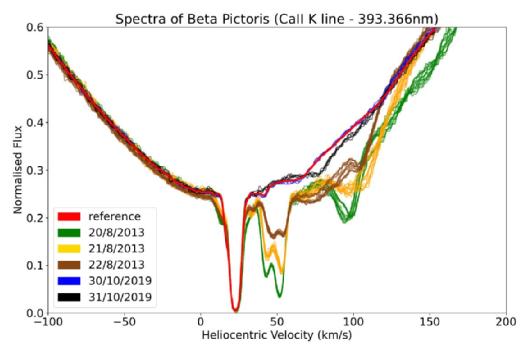
Exocomets are analogues of solar system comets, with the main difference being that they orbit stars other than the Sun. These extrasolar comets can be thought of as small icy planetesimals that were left unused during the planet formation phase of a system. Although being “leftover” dust agglomerates, exocomets tend to be part of the most pristine objects in a system, enclosing primordial information about the early phases of planetary formation.
The field of exocomets has been built around the unmatched number of detections made in the circumstellar disc of the archetypal star Beta Pictoris. An exocomet detection is identified by variable absorption features around atomic lines in a stellar spectrum (typically around the ionised Calcium doublet), which can be explained by the interaction between the light emitted by a star and the transiting gas that is in and trailing an exocomet coma. Variability in the CaII doublet has been observed around approximately 30 different stars – certain detections being clearer than others, emphasising the rarity and difficulty to observe such events.
In this talk, I will show results from an automated search through the HARPS archive for signs of exocomet transits. Such a spectroscopic survey is unprecedented mainly due to the large quantity and wide variety of stars being observed. This talk will introduce our newly developed automated search algorithm that quantifies the rate of CaII exocomet absorption events in archival spectra, with the goal to estimate the occurrence rate of transiting exocomets.
Azib Norazman -- An Automated Search for Transiting Exocomets with TESS
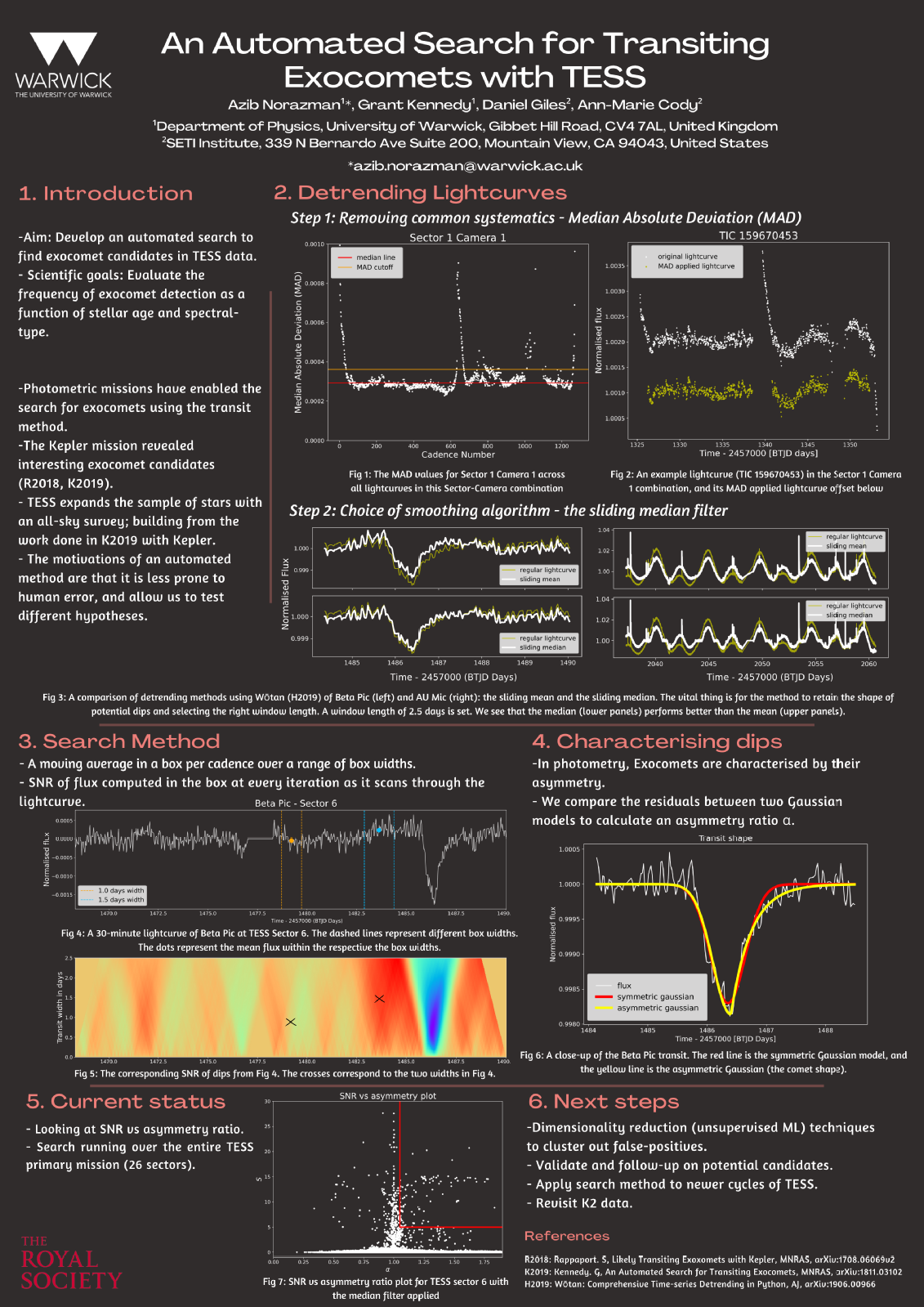
The term exocomets refers to analogues of our Solar System comets. They are small icy planetesimal bodies that orbit stars other than the Sun and are thought to be the remnants of exoplanet formation. In recent years, there have been a small number of stars that have unique asymmetric dips in their transits from photometric data that cannot be caused by a planet transit. The most prominent example of this so far are from the lightcurves of Beta Pictoris, a young A-type star. Recent literature has also indicated that exocomet detections are more likely in younger, A/F-type stars. As the TESS mission carries out an all-sky survey, there is now the opportunity to explore this hypothesis further and explore the detection rates of exocomets with relation to the spectral type of their host star- uncovering the occurrence rates as a function of spectral type and stellar age. A simple automated method to detect exocomet transits was developed for the Kepler mission. As TESS expands the sample of stars over the whole sky, a plethora of star systems will be explored. However, the nature of the all-sky search results in a wide range of astrophysical variability in addition to the different systematics the spacecraft has compared to Kepler. Therefore, development of the search method for TESS is essential. We present the automated search algorithm used to find potential asymmetric transit dips in TESS, and the results of my search at the time of the conference.
UKEXOM 2021
Sahl Rowther -- Giant Planets Can Suppress Gravitational Instabilities In Protoplanetary Discs
The work covered in this talk is described in Rowther et al. 2020.
KITP Online Conference: White Dwarfs from Physics to Astrophysics
Christopher Manser -- Gaseous planetary discs around white dwarfs
Five Years After HL Tau
Sahl Rowther -- Are Gravitationally Unstable Protoplanetary Discs Rare?
The work covered in this talk is described in Rowther et al. 2020.
Rebecca Nealon -- Spirals, Shadows and Precession in HD 100453 Part 2
Part 1 can be viewed here.
Dimitri Veras - Constraining Planet Formation Around 6-8 Solar Mass Stars
The work covered in this talk is described in Veras et al. 2020.
Exoplanet Demographics
Christopher Manser -- Doppler Imaging of a Second Planetary Debris Disc Around a White Dwarf
Talk begins at 4:16:02.
Dimitri Veras -- Full-lifetime Simulations of Planetary Systems
Talk begins at 2:00:00.
Catriona McDonald -- Triaxial Asteroids as Reservoirs for Planetary Debris around White Dwarfs
Here, we present an analytical framework incorporating tidal, self-gravitational and internal strength forces to triaxial ellipsoids approaching a white dwarf on extremely eccentric (e ~ 1) orbits. Such extreme orbits could be produced by dynamic interactions with planets in the white dwarf system. The subsequent disruption of the asteroids is split into three distinct regimes: tidal fragmentation, sublimation, and direct impact. This framework is extended to cover a simplified Main Belt analogue of 100 planetesimals with an observational size distribution and randomly chosen shape model and material, for a range of white dwarf temperatures. We find that using a spherical shape model consistently underestimates where sublimation occurs and overestimates fragmentation distance. The small spatial scales of white dwarf planetary systems can cause these discrepancies to have a large effect on predicted debris distributions. Our results allow us to place constraints on the expected planetary debris from asteroids at different white dwarf cooling ages and motivates future studies to include more accurate shape models
Exoplanets III
Sahl Rowther -- Hiding Signatures of Gravitational Instability in Protoplanetary Discs
We carry out three-dimensional smoothed particle hydrodynamics simulations to show that a migrating giant planet strongly suppresses the spiral structure in self-gravitating disks. We present mock Atacama Large Millimeter/submillimeter Array (ALMA) continuum observations that show that in the absence of a planet, spiral arms due to gravitational instability are easily observed. Whereas in the presence of a giant planet, the spiral structures are suppressed by the migrating planet resulting in a largely axisymmetric disk with a ring and gap structure. Our modeling of the gas kinematics shows that the planet's presence could be inferred, for example, using optically thin 13C16O. Our results show that it is not necessary to limit the gas mass of disks by assuming high dust-to-gas mass ratios in order to explain a lack of spiral features that would otherwise be expected in high-mass disks.

